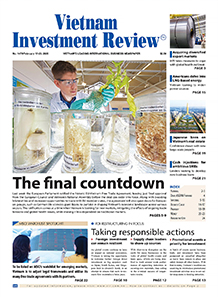AI and innovation reshape Vietnam’s journalism industry
These themes were at the forefront of discussions during the workshop on foreseeing the future of journalism on June 4 in Hanoi.
Speaking at the event, Le Quoc Minh, a member of the Party Central Committee and president of the Vietnam Journalists Association, underscored the vital role of innovation and digital tools in transforming newsrooms.
Minh noted the increasing reliance on AI tools within the journalism field, emphasising the importance of practical, editorially focused applications over those designed primarily for entertainment.
“Such technologies are becoming essential for conducting research and producing content. They can assist journalists in verifying information, conducting research, and developing meaningful content,” said Minh.
Despite the growing availability of such technologies, Minh observed that Vietnam’s media landscape has been relatively slow to embrace key innovations that are now considered standard elsewhere, such as personalised content delivery and integration with wearable devices.
“We are still relatively slow in embracing technology,” he added. “Vietnamese press agencies should experiment with emerging platforms and better anticipate shifts in audience behaviour.”
Le Mai Anh, communication specialist and regional country manager at Global PR Hub, cited a global survey showing that 42 per cent of journalists see shifting content consumption habits as their biggest challenge in 2024. Meanwhile, 58 per cent are worried that the rise of AI could weaken content quality and damage public trust.
“These concerns are increasingly relevant in Vietnam, where digital platforms are expanding rapidly, offering new avenues for storytelling, but also intensifying competitive pressure. To succeed, media organisations must raise content standards while navigating new technologies,” Anh said.
Nguyen Van Ba, editor-in-chief of Vietnamnet, presented a more structural view of the transformation underway. He stated that the future of journalism depends on the strategic integration of three interconnected pillars: content, business, and technology.
“This is not just an ideal model, it is a matter of survival. We must rethink journalism as a system that delivers verified information, independent perspectives, and tailored experiences to its audiences,” said Ba. “Media outlets must move beyond traditional advertising models and explore diverse revenue streams, including long-form content, branded events, and digital subscription products.”
The importance of embedding technology was echoed by Ngo Viet Anh, director of the Media Development Centre at Nhan Dan newspaper. He described digital tools as a “new creative material” that can enrich storytelling, enhance operational efficiency, and unlock new revenue potential.
“Nhan Dan has incorporated advanced technologies such as AI, VR, and interactive Q&A platforms to improve user engagement and reach new audiences. These innovations are helping traditional media adapt to an increasingly digital environment,” Anh said. “Positioning technology at the heart of our editorial strategy is essential. It allows us to expand our distribution channels and diversify our business models while continuing to serve the public interest.”
The digital transformation of journalism is also prompting a deep re-evaluation of how future media professionals are trained. As the news industry becomes more data-driven and tech-enabled, journalism education must undergo a fundamental shift in structure, delivery, and philosophy.
This call for change was a major focus at the workshop on training and fostering media staff, held on June 7 by the Academy of Journalism and Communication (AJC).
Assoc. Prof. Duong Trung Y, vice president of the Ho Chi Minh National Academy of Politics, argued that the digital revolution has reshaped the ways information is created, shared, and consumed, making it critical to modernise journalism education.
“We must equip students to build digital portfolios that show their real abilities, by blending theory with hands-on experience. Multidisciplinary, practice-based training models are no longer optional, they are essential,” he said.
He further emphasised the need to integrate digital tools, big data, and AI into journalism curricula to equip students for cross-platform storytelling, audience analytics, and responsible content production.
Assoc. Prof. Pham Minh Son, director of the AJC, said journalism education must be urgently updated to keep up with industry change.
Son advocated for a modern, practice-oriented, and learner-centred training philosophy. He further emphasised the importance of fostering stronger collaboration among academic institutions, media organisations, and technology enterprises to develop a robust and future-ready talent ecosystem.
“To meet the demands of today’s fast-evolving media landscape, journalism education must become more practical, modern, and student-centred,” said Son. “Building stronger links between academia, media, and technology is essential to nurturing a skilled and future-ready workforce.”
What the stars mean:
★ Poor ★ ★ Promising ★★★ Good ★★★★ Very good ★★★★★ Exceptional
 Tag:
Tag:
Related Contents
Latest News
More News
- Administrative restructuring must not disrupt high school graduation exam: PM (June 19, 2025 | 10:13)
- Vietnam pledges to promote gender equality at UN meeting (June 19, 2025 | 10:10)
- Deputy Minister of Home Affairs suspended from duty (June 19, 2025 | 10:03)
- Herbalife Vietnam supports VnExpress Marathon Quy Nhon 2025 (June 17, 2025 | 17:38)
- Major administrative reform to boost growth and efficiency (June 13, 2025 | 18:53)
- Legal proceedings launched against ex-official for taking bribes (June 12, 2025 | 16:29)
- Trading centre falls silent following tax and counterfeit crackdown (June 10, 2025 | 13:58)
- Volunteers join forces to clean up Nghi Son Bay (June 10, 2025 | 12:56)
- First Vietnamese-American woman in space inspires graduates (June 10, 2025 | 11:44)
- No violation at C.P. Vietnam chicken processing factory (June 07, 2025 | 08:00)


















 Mobile Version
Mobile Version